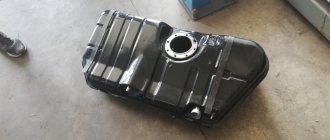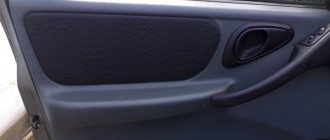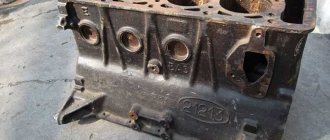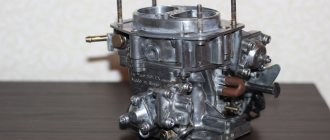Engine
The gasoline engine with a carburetor power supply system is located transversely at the front. Unit volume 1.5 l. with a power of 76 hp. and 5600 rpm, 4 in-line cylinders with 8 valves.
Later, the engine was modernized and 16 valves were built into it, like on most modern cars. The maximum speed of the engine is 165 km/h, and acceleration to 100 km/h is possible in 13.2 seconds.
Its fuel consumption is economical:
- in the city 8.9 l/100 km.
- on the highway 6.5 liters.
- in mixed mode 7.6 l.
In addition to the main engine option, the “tag” has various power variations of the 1.6 liter engine: 80/81/98 hp. With this unit installed, the car can accelerate to 160 km/h in 13.5 seconds. to "hundredth".
Consumption accordingly also increases to 10 liters in the city, 5.7 liters. outside the city and 7.6 l. average. The system of such an engine has been changed, and fuel injection is carried out multipoint. Even fuel costs more to use, namely AI 95. If you wish, you can choose a 1.3 liter engine and a 1.5 liter, but with 78 hp.
VAZ 2115 engines
- 1.5 l, 8-cl, 70 hp
- 1.5 l, 8-cl, 78 hp
- 1.6 l, 8-cl, 81 hp
- 1.6 l, 8-cl, 82 hp
| Engine make | VAZ 21083 |
| Engine capacity, cubic meters cm | 1499 |
| Number of valves | 8 |
| Maximum power, hp | 70 |
| Transmission type | 5 manual transmission |
| Speed at maximum power, rpm | 5600 |
| Maximum torque, N*m | 104 |
| Speed at maximum torque, rpm | 3400 |
| engine's type | in-line, 4-cylinder |
| Supply system | carburetor |
| Recommended fuel | gasoline AI-92 |
| Fuel consumption | |
| Fuel consumption in the urban cycle, l/100 km | 8,9 |
| Fuel consumption in the extra-urban cycle, l/100 km | 5,7 |
| Fuel consumption in the combined cycle, l/100 km | 7,8 |
| Dynamic indicators | |
| Acceleration time 0-100 km/h, s | 13 |
| Maximum speed, km/h | 155 |
The “fifteenth” differs from its predecessor, the VAZ 21099, not only in technical characteristics, but also in appearance: narrow headlights, side skirt fairings, new painted bumpers, rounded body corners. A spoiler with a brake light is installed on the trunk lid; In addition, the loading height of the trunk was brought to the level of the bumper, which made loading things much more convenient. The car body has become longer by 22.5 cm.
Electrical equipment has also been improved. The VAZ 2115 package includes power windows for the front doors, an on-board monitoring system that allows you to monitor the proper operation of the main systems, as well as fog lights and heated seats (on “luxury” modifications).
In the interior of the car, a number of shortcomings characteristic of the first Samaras were eliminated. Thus, the instrument panel (European panel) stopped creaking, it became possible to adjust the position of the steering column, the shape of the seats changed, etc.
Initially, the developers planned to equip the VAZ 2115 with original components - transmission, brake system, etc., however, due to high costs, these innovations remained on paper, and the main units were borrowed without significant changes.
Weight category VAZ-2115
The car is quite light; the curb weight of the VAZ 2115 will be 970 kg with the basic configuration and 1 ton with the standard and luxury configuration.
The permissible gross weight is 1395 kg, which corresponds to 425 kg of the vehicle's carrying capacity.
It is worth mentioning the weight of the trailer without brakes is a possible 300 kilograms and with brakes is a maximum of 750 kilograms.
Description and characteristics of the VAZ-2115
The model of this car was developed in 1994, it was supposed to replace the VAZ-21099.
But due to the difficult economic situation, production of the VAZ2115 car began only in 1996. Production was carried out in small batches and almost all cars were exported. By that time, the appearance of the car was modern. The appearance was somewhat spoiled by the poorly thought-out sill fairing. Its goal was to reduce aerodynamic drag, but in appearance it resembled a flaw of novice tuners. In 2001, the VAZ-2115 began to be assembled on an assembly line. Until 2001, it was almost impossible to buy a VAZ2115; the car was very popular and it was prestigious to drive.
What changes were made to the VAZ 2115 compared to the VAZ 21099 in appearance:
- the shape of the front and rear bumpers has been changed;
- bumpers were painted in body color;
- sill fairing;
- door moldings;
- the shape of the hood has been changed;
- the headlights have become narrower;
- new taillights;
- wing on the trunk lid;
- alloy wheels;
- shape of the front wings;
- trunk lid;
Inside the car:
- height-adjustable steering column;
- new instrument panel;
- heated seats;
- power windows for front doors;
- on-board control system;
- The first small-scale cars, produced from 1996 to 2001, were equipped with a 1.5-liter carburetor engine. This is the engine that was installed on the V8s.
- Since 2001, when production moved to the factory assembly line, a 1.5-liter engine with distributed fuel injection began to be installed on the VAZ2115 car.
- Since 2007, a 1.6-liter injection engine has been installed.
- The car was produced until 2012 inclusive.
Size, weight, speed, acceleration to 100 km/h
| Name of parameters | VAZ-2115 | |
| Dimensions, mm: length, mm width, mm height, mm | 4330 1650 1420 | |
| Base, mm | 2460 | |
| Front track, mm | 1400 | |
| Rear track, mm | 1370 | |
| Ground clearance, mm | 165 | |
| Turning radius, m | 5,2 | |
| Curb weight, kg | 985 | |
| Total weight, kg | 1410 | |
| Load capacity, kg | 425 | |
| Acceleration time 0–100 km/h, sec. | 14,2 | |
| Maximum speed, km/h | 158 | |
| Fuel | AI-95 | |
| Fuel capacity, l | 43 | |
| Fuel consumption (EU 99/100), l/100 km: at a speed of 90 km/h at a speed of 120 km/h urban cycle | 5,7 7,8 8,9 | |
Body | ||
| Body type | sedan | |
| Number of doors | 4 | |
| Number of seats | 5 | |
| Trunk volume (VDA), l | 430 | |
| Engine | ||
| Location | front transverse | |
| Configuration | P4 | |
| Number of valves | 8 | |
| Working volume, cubic cm | 1499 | |
| Supply system | distributed injection | |
| Neutralizer | There is | |
| Toxicity standards | Euro 2 | |
| Compression ratio | 9,8 | |
| Power, kW/hp at rpm | 56,4/76,7 5400 | |
| Torque, N*m at rpm | 115,7 3000 | |
Transmission | ||
| Type | front-wheel drive | |
| Transmission | M5 | |
Chassis | ||
| Front suspension | McPherson type | |
| Rear half-link | elastic beam | |
| Steering | rack and pinion | |
| Front brakes | disk | |
| Rear brakes | drums | |
| Tire size | 165/70R13, 175/70R13 | |
| Equipment | Standard | Lux |
| Rear window defroster | There is | There is |
| Power windows for front doors | There is | There is |
| Heated front seats | No | There is |
| Immobilizer | There is | There is |
| On-board computer | No | There is |
| Fog lights | There is | There is |
| Exterior mirrors | with anti-glare effect | with anti-dazzle effect and electric drive |
| Seat upholstery | tweed | velvet |
| Vegetable padding on the front seat backs | There is | There is |
| Trunk spoiler with brake light | There is | There is |
| Tinted windows | No | There is |
Technical characteristics of the VAZ2115 video
Specifications
| Type | Volume | Power | Torque | Overclocking | Maximum speed | Number of cylinders |
| Petrol | 1.5 l | 68 hp | 103 H*m | 13 sec. | 155 km/h | 4 |
| Petrol | 1.5 l | 78 hp | 115 H*m | 13.2 sec. | 158 km/h | 4 |
| Petrol | 1.6 l | 81 hp | 120 H*m | 13.2 sec. | 160 km/h | 4 |
More details
The model had weak units with a volume of 1.5 and 1.6 liters in its line; you can see their characteristics above. They were paired only with a 5-speed manual transmission. Nevertheless, for some time there was a package that equipped the model with a 1.3-liter rotary carburetor unit producing 135 horsepower, allowing the model to reach a hundred in 9 seconds.
The 1.5-liter unit produces 68 horsepower, not much, but enough to accelerate the model to hundreds in 13 seconds. The maximum speed will be 158 km/h. Consumption is around 9 liters in the city and it is advisable to fill in 95 gasoline.
There is also an 8-valve engine with a volume of 1.5 liters, but producing 78 horses. Despite the increased power, the dynamics became worse, but the maximum speed increased to 165 km/h.
The latest engine is also an 8-valve engine, but its volume has been increased to 1.6 liters. Exactly the same dynamics as the previous units, the maximum speed is generally 160 km/h. At the same time, it consumes as much as 10 liters of gasoline in the city.
VAZ 2115: technical characteristics
The 15th model has been modernized more than once over the entire production period. From the beginning of 2000, it was produced as the VAZ 21150, the technical characteristics of which were much better.
Dimensional parameters.
| Body type | Sedan |
| Number of doors/seats | 4 / 5 |
| Length | 4330 mm |
| Width | 1620 mm |
| Height | 1415 mm |
| Wheelbase | 2460 mm |
| Front/rear track | 1400 / 1370 mm |
| Ground clearance | 160-170 mm |
| Trunk volume | 427 l |
| Curb weight | 970 kg |
| Permissible (gross) weight | 1395 kg |
| Volume of the tank | 43 l |
Engine
The predecessors were equipped with carburetor four-cylinder engines of 1.1 and 1.3 liters. But after 1999 they were written off, and the fifteenth model received a newer power unit. The VAZ 2111 came off the assembly line with a 1.5-liter engine equipped with distributed injection with a power of 77.8 liters. With.
Since 2007, VAZ 11183 began to be equipped with injection engines with a volume of 1.6 liters and a power of 80.9 liters. With. Structurally, they were practically no different from the previous version, only the piston stroke changed (from 71 to 75 mm), and the cylinders increased to 82 mm, which led to an increase in volume and power.
The installation of higher power engines made it possible to improve the parameters of the car. The maximum speed reached 170-180 km/h, but the acceleration time to 100 km/h changed little and amounted to 14 s. Average fuel consumption in city mode is 10 liters, but on the highway it does not exceed 5.7 liters.
Transmission and suspension
“Pyatnashka” is a front-wheel drive sedan with a standard five-speed manual transmission. The gearbox has one difficulty: first gear and reverse gear are engaged in the same way, which leads to unpleasant situations, especially when moving backwards.
The chassis is durable and resistant to poor quality road surfaces. This car has earned special love from car owners. The front suspension is a shock absorber strut, the rear suspension is a coil spring. The model is stable on the road, easy to control and unpretentious.
Steering and brake system
The steering has a rack and pinion mechanism and two rods, which have rubber-metal joints on the steering mechanism side and ball joints in the area of the swing arms. The standard steering wheel size is 37 cm (M). The basic configuration does not include an amplifier. The control of the “tag” is considered injury-proof (this is confirmed by motorists who have crash-tested the car) and convenient, thanks to the adjustable angle of the steering column.
The car's braking system is quite simple. The front wheels are equipped with disc mechanisms, and the rear wheels are equipped with drum mechanisms. A working system with diagonal separation of contours is used. One ensures the operation of the front left and rear right mechanisms. The hydraulic drive circuit is responsible for the operation of the opposite pair of brake elements. This ensures high driving safety.
If one circuit fails, the second will be used, which will ensure shutdown with sufficient efficiency. The handbrake has a drive to the brake mechanisms of the rear wheels. The luxury package was complemented by ABC.
Electrical equipment
In addition to the standard generator, battery and starter, cars of this brand in some trim levels were equipped with heated driver and passenger seats, as well as power windows on the front doors. Additional signaling devices (controllers) were built in to inform the driver about certain problems. All additional options could be installed only at the request of the buyer.
Technical characteristics of VAZ 2115
Performance characteristics of the VAZ 2115 fifteenth sedan
Maximum speed: 170 km/h Acceleration time to 100 km/h: 14 sec Fuel consumption per 100 km in the city: 10 l Fuel consumption per 100 km on the highway: 5.7 l Fuel consumption per 100 km in the combined cycle: 7.3 l Fuel tank volume: 43 l Vehicle curb weight: 970 kg Permissible gross weight: 1395 kg Tire size: 175/70 R13
Engine characteristics
Location: front, transverse Engine capacity: 1500 cm3 Engine power: 78 hp Number of revolutions: 5400 Torque: 115/3000 N*m Power system: Distributed injection Turbocharging: no Gas distribution mechanism: OHC Cylinder arrangement: In-line Number of cylinders: 4 Cylinder diameter: 82 mm Piston stroke: 71 mm Compression ratio: 9.9 Number of valves per cylinder: 2 Recommended fuel: AI-95
Brake system
Front brakes: Disc Rear brakes: Drum ABS: yes
Steering
Power steering: no Steering type: Rack and pinion
Transmission
Drive: Front Number of gears: manual gearbox - 5 Gear ratio of the main pair: 3.9
Suspension
Front suspension: Shock absorber Rear suspension: Coil spring
Body
Body type: sedan Number of doors: 4 Number of seats: 5 Vehicle length: 4330 mm Vehicle width: 1620 mm Vehicle height: 1415 mm Wheelbase: 2460 mm Front track: 1400 mm Rear track: 1370 mm Ground clearance (clearance): 160 mm Trunk volume: 427 l
Production
Year of manufacture: from 1997 to 2012
Car VAZ-2115
VAZ-2115 / Lada Samara is a four-door front-wheel drive sedan developed by the Volzhsky Automobile Plant).
The updated VAZ-2115 sedan was created as part of the Samara-2 project, work on which began in the early 90s. Moreover, thinking first of all about the new appearance of front-wheel drive cars, in Tolyatti they did not forget about aerodynamics. Therefore, in 1993, the VAZ design team came to the Dmitrov Automotive Test Site - the VAZ team decided to work on the style of the updated cars right in the wind tunnel!
We started by removing standard bumpers from ordinary VAZ-21093 and VAZ-21099 cars, and in their place they fitted new ones, which were fashioned from plasticine. The designers noticeably rounded the corners of the plasticine bumpers, and along the lower edge of the side doors they placed developed sill moldings that “flow” onto the edges of the wings. Using the same technology, a new, slightly longer and sharper “muzzle” was made. The appearance was complemented by a small wing on the trunk lid.
After several “purge” sessions in the wind tunnel, during which the shape of all parts was optimized, the designers came to the final version of the plasticine “armor”. And we went back to Togliatti. And a few months later, “live” Samara-2, embodied in metal and plastic, was driven to Dmitrov! These were the VAZ-2113 and VAZ-2114 hatchbacks - an alternative to the “eights” and “nines” - and the VAZ-2115 sedan, which was supposed to replace the “ninety-ninth” model. The Togliatti residents were generally satisfied with the results of the car purging and were already planning to prepare Samara-2 for mass production. The year was 1994.
Then the crisis came. The main forces and funds at the plant were devoted to finishing work on the “ten”, and funding for the Samara-2 project was severely cut. And as a result, of the three cars, they decided to bring only the VAZ-2115 to mass production. Almost two years were spent on this. Only in 1996, the “fifteenth” began to be produced in small batches at the VAZ pilot production facility. Since 2001, assembly began on the factory assembly line.
In comparison with its predecessor (VAZ-21099), the VAZ 2115 has lengthened by 225 mm. The appearance of the car has noticeably changed - the front and rear parts have been changed, the interior has been updated, while the sides, doors and roof remain the same. The new model is distinguished by the front part of the body with original headlights, a modified shape of the hood and front fenders, new taillights with an insert between them, bumpers painted in body color, a trunk spoiler with an additional brake light, door moldings, door sill fairings, a new trunk lid with floor level connector. New efficient lighting technology is provided.
A number of design solutions were borrowed from the “tenth” family of VAZs - an adjustable steering column, upper mounting points for front seat belts, and an instrument cluster. The rear number of the car, like on the “ten”, is located on the bumper.
The car is equipped with 1.5 and 1.6 liter petrol engines. Initially, modifications with a carburetor engine were produced. But in 2001, a modification was released with an engine with distributed fuel injection. To increase service life and reduce noise at idle, a new clutch driven disc with an idle damper is provided.
The display unit of the on-board control system carries information about closing the door locks, unfastened seat belts, extreme wear of the brake pads, the ignition key left, the level of oil, coolant and washer fluids. The new heater design used ensures efficient heating of the interior.
The VAZ-2115 is available in the following configurations: “standard” (VAZ-21150-20), “norm” (VAZ-21150-21) and “luxury” (VAZ-21150-22).
VAZ 2115 configurations
This popular descendant of the VAZ 21099, a prominent representative of the Samara-2 family, is a compact B class sedan.
Produced from 1997 to 2012 in three main trim levels:
- “Standard” VAZ 21150-20-ST;
- “Norma” VAZ 21150-21-NR;
- "Lux" VAZ 21150-22-LX.
The 20-ST package did not include any additional elements or options other than standard seat belts and electric door locks. The interior is without any special decorative details, with tweed seat upholstery and solid fabric inserts on the side panels.
With the advent of the “21–NR” (standard) configuration, the car was equipped with fog lights, seat belt warning lights and heated front seats. The electrical equipment was supplemented with front door window lifts.
The most equipped car was the Luxury class car (22-LX). In addition to everything that was in previous trim levels, buyers now have a choice of interior trims. The seat upholstery was made not only of tweed material, but also of velvet.
The level of car safety has increased thanks to the built-in ABS (anti-lock braking system). Installing power steering made the car easy to control and maneuverable.
In addition there were:
- rear side window lifts;
- heated rear seats;
- headlight cleaners;
- factory tinted windows.
About VAZ-2115
The VAZ-2115, part of the Lada Samara line, is radically different from its predecessor both in appearance and, accordingly, in dimensions. The front-wheel drive subcompact sedan developed by VAZ is no longer produced. Its production began in 1997 and closed not so long ago - in 2012, which is quite reasonable, given the speed of modernization of vehicles.
This model became the first-born of its line and was designed under the code name “Samara-2”. The basis of the modernization is to change the rear part of the body - lighting devices and the luggage compartment lid.
The entire model is a restyling of the VAZ-21099.
If you look closely, there are quite a lot of differences:
- more rounded sections of the body;
- trunk lid shape;
- rear and front optics;
- bumpers painted to match the body color;
- door moldings;
- threshold fairings;
- spoiler with additional brake light;
- completely new interior;
- improved electrical equipment.











